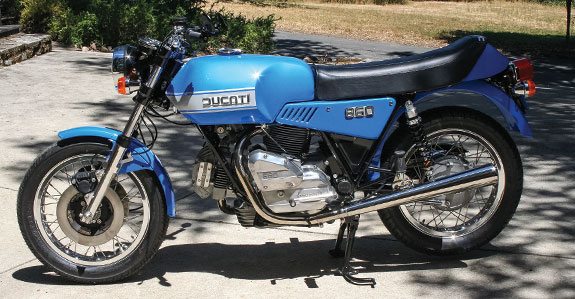
When descriptions of a motorcycle run like this: “exceedingly ugly,” “slab-sided ugly duckling,” “Stateside reception…barely rose to lukewarm,” “judged a disaster,” it might well be expected that this was a sales flop. Which the Ducati GT, and the electric-start GTE version, were. As one current observer notes, not many stock GTs are around, because the original was just too unattractive and changes were often made.
Back in ’74, its new engine cases had hard, straight lines, while the gas tank complied with the design by having flat sides. And the dual saddle just sort of ended, sticking up in the sky. And rather high bars were mounted, which some testing types thought made the bike wobble a bit at high speeds.
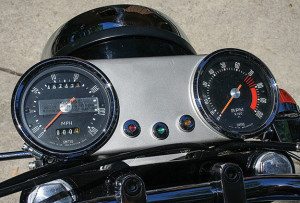
In the early ’70s, ownership of the Ducati firm was in the hands of the Italian government, and Italian bureaucrats have their own way of doing business. One being that when a state-owned company runs into financial problems, the government likes to send in someone to fix the situation…whether or not that person has any familiarity with the business. In 1972, an engineer named Cristiano de Eccher was made general manager to remedy the cash-flow problem that this middling-sized motorcycle company had, and he decided that the solution was to cut costs and increase production.
Unfortunately, de Eccher was not a motorcycle enthusiast, and had absolutely no aesthetic nor emotional attachment to the sport. He was strictly numbers. To cut costs, he severely curtailed the racing schedule, and for 1973 the factory showed up only for the Imola 200 and the Bol d’Or 24-hour in France. Not wise, as the racing successes of the marque were a major factor in its appeal to buyers.
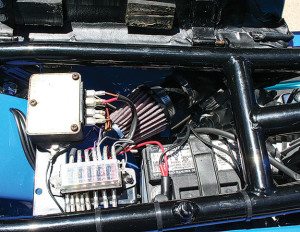
He planned to expand sales by greatly increasing production to 15,000 units and aiming mainly for the American market. By boring out the popular 750 engine 6mm he could have an 864, which could be sold to the bigger-is-better U.S. consumer as an 860. The GT stood for Grand Touring, so this was to be advertised as a comfortable street bike, ignoring the racing success of the desmo 750SS. To compound his mistake, de Eccher decided to hire an automotive designer to style this new bike, and went to the ItalDesign Studio, where Giorgio Giugiaro was well known for turning out some good-looking cars like the Maserati Ghibli and VW Golf. But he had never done a motorcycle.
So Giugiaro decided to give the 860 a “folded-paper look,” an angular design that most motorcyclists found singularly unattractive. When the GT first appeared at the Milan show in November 1973, it was up against its own stunning sibling, the 750SS, as well as Laverda’s 750 SFC and Moto Guzzi’s 750S. The peculiar lines of the 860 stuck out like a sore thumb…or perhaps better said, like the box the 750SS came in.
At the factory, most, if not all, of the staff did not like de Eccher’s approach, especially Fabio Taglioni, the man responsible for Ducati’s racing successes. Taglioni had been working on a 500cc L-twin, but de Eccher nixed that and told R&D to come up with a parallel twin, very much in the Japanese style, in 350 and 500 sizes—because a parallel twin was cheaper to build than an L-twin.
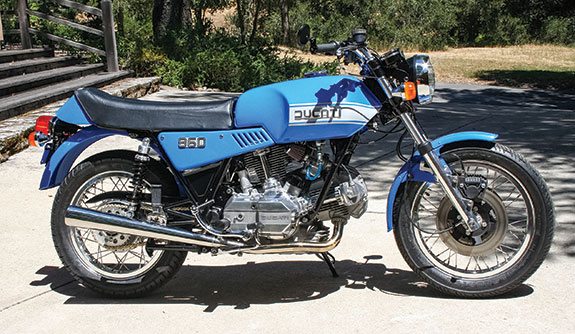
The 860 was not a bad machine, and the boring-out made the engine majorly oversquare, which is useful in slow riding around town. Power was around 60 horses at 6,900 rpm. It did not have the technical romance nor the headaches of the desmodromic heads, but instead used the simpler bevel-driven overhead camshafts where the valve clearances were adjusted with screws and locknuts. Bearings were improved, and the new Elettrotecnica CD ignition was an improvement, with the spark advance done electronically. And the new disposable oil filter was certainly a plus.
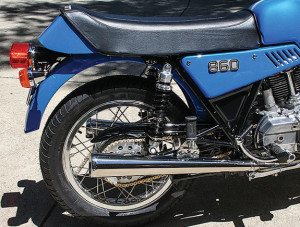
The frame had been slightly altered from the 750 bikes to accommodate the newly designed engine cases. Wheelbase was a tight five feet, with a 38mm Ceriani fork at the front, a pair of Marzocchi shocks at the back. GT weight was 500 pounds at the curb, and the addition of the electric starter and bigger battery would add another 22 pounds to the GTE.
The production of the 860GT began in September of 1974, and the electric-start GTE started the next January. The total production of these two models was a modest 2,987. Of which at least a third remained unsold by the end of 1975.
Admittedly, the world economy was in a bit of a slump, but instead of the 15,000 sales de Eccher had boasted about, Ducati didn’t get even 6,000. The four-stroke singles had been dropped from the line, the limited-edition 750SS sold out, the 125cc dual-purpose, two-stroke Regolarita was OK, but sales of the 350/500 GTL parallel twins were terrible, as were those of the 860GT.
De Eccher was out as of December 1975. As was Giugiaro. A new manager well acquainted with the moto-world was brought in. Factory folk redesigned the GT’s tank and seat, and put those on the unsold 850s, calling it the GTS. Taglioni was invited back into the fold, and his 500cc Pantah L-twin showed up in 1978.
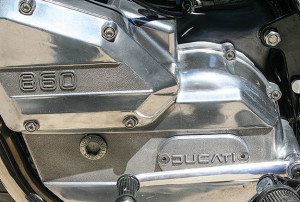
A touch of history here. The current owner, John Laughney, an aesthetically minded restoration fellow, bought this piece from long-time speed-record holder Marty Dickerson, who had owned it since new. John found the Giugiaro-look not to his liking, and knew where to get a GTS tank. He also dressed up the back of the saddle with a small curved cover, giving it an entirely new look. But John’s keeping the original tank up in the rafters of his workshop, just in case.








I had one of these, back in the day; in orange. The original owner had modified it with Mikuni carbs and aftermarket mufflers, and it was a good runner! Grunty as all get out, by the standards of the day, with long, slow handling; but once you got used to muscling it around, it was stable as a train in the corners.
Compared to everything else out there, it was … unique. But, it ran well, I was fearless, and it fueled this young man’s dreams of freedom.
I bought a leftover 1975 GT new in 1976. Before I took delivery from the dealer, I had the Conti racing megaphone mufflers and better Continental Tires, and the front forks that the italians used on their 750’s. I hated the way it looked as a stock Ducati, but mine looked much better with the factory add-ons, including the lower look bc of the different front forks. In the 3 years I owned mine, it was 100% reliable, smooth running, and pulled strongly past 100, then topping out at 124 mph. That bike had a very trick, racing type rear chain adjuster. The entire swing arm could be unlocked, slid forward or backwards to tighten or loosen the chain. I surprised many Kawasaki Z riders when they found out not only would the not smoke me, but they had a hard time catching me in a stoplight to stoplight race. My Ducati had only one flaw, in a downpour of rain, it wouldn’t run very long. The float bowls would fill with water and conk out. I’d pull off the road, unclip the float bowls from each carb, shake out the water/fuel mix, clip the bowls back on, and I could usually go another mile or two before I had to do it again. It was, out of all the big bikes ai ever had, the best one. It was a way better bike, than I was a driver, and I routinely scared myself with what it was capable of. I miss it.
Hi Michael
I read your comments with interest as I also bought a GT/ES in 1976 here in the UK. I still have mine albeit in bits and have just started to put it back together.
I travelled appx 100,000 miles over 7 years travelling all over Europe, Canada, USA and Australia. I was in my early 20’s at the time.
It was a reliable ride but notably the rim departed from the wheel and the lay shaft end bearing broke through the casing.
I rode to Bologna in Italy in 1977 and no one in the town believed it was a Ducati !
It was a great touring bike, hence why I still have it. I crossed the deserts of N Africa in the early 80’s ( not on a Ducati) and met a french couple attempting the same on a 750 round case but he was having lots of issues with his gearbox. I think he became jealous of the guy doing it on a Honda 50
It’s all KTMs & BMW’s now. Happy times had by all.